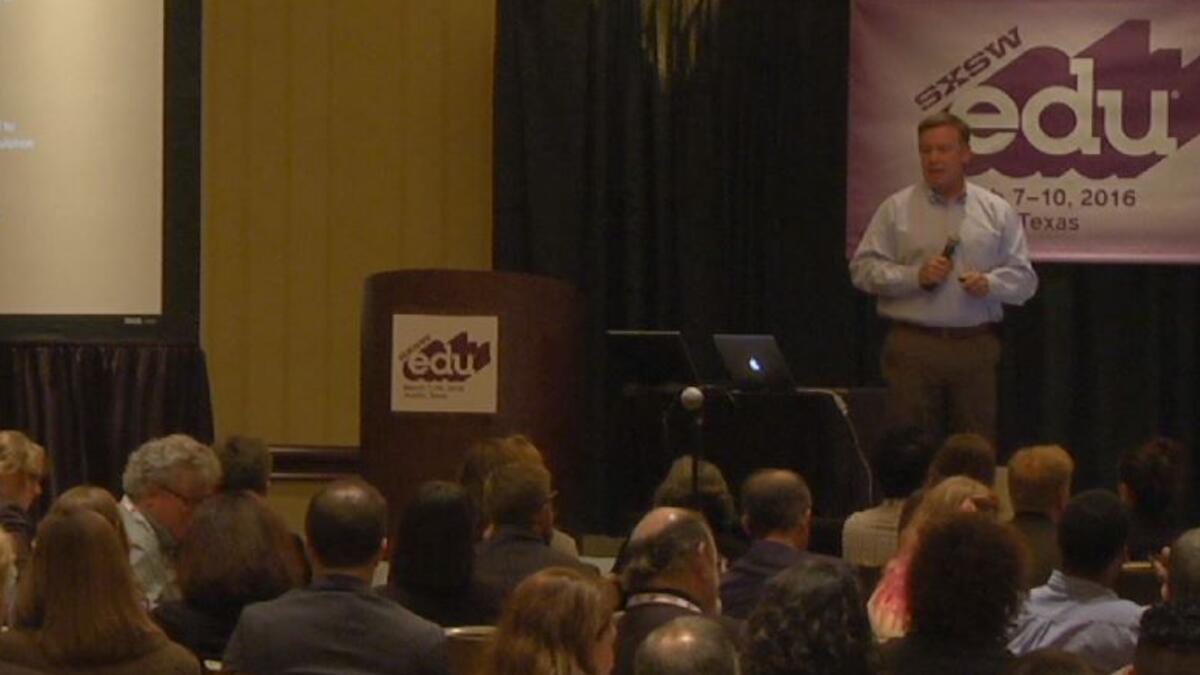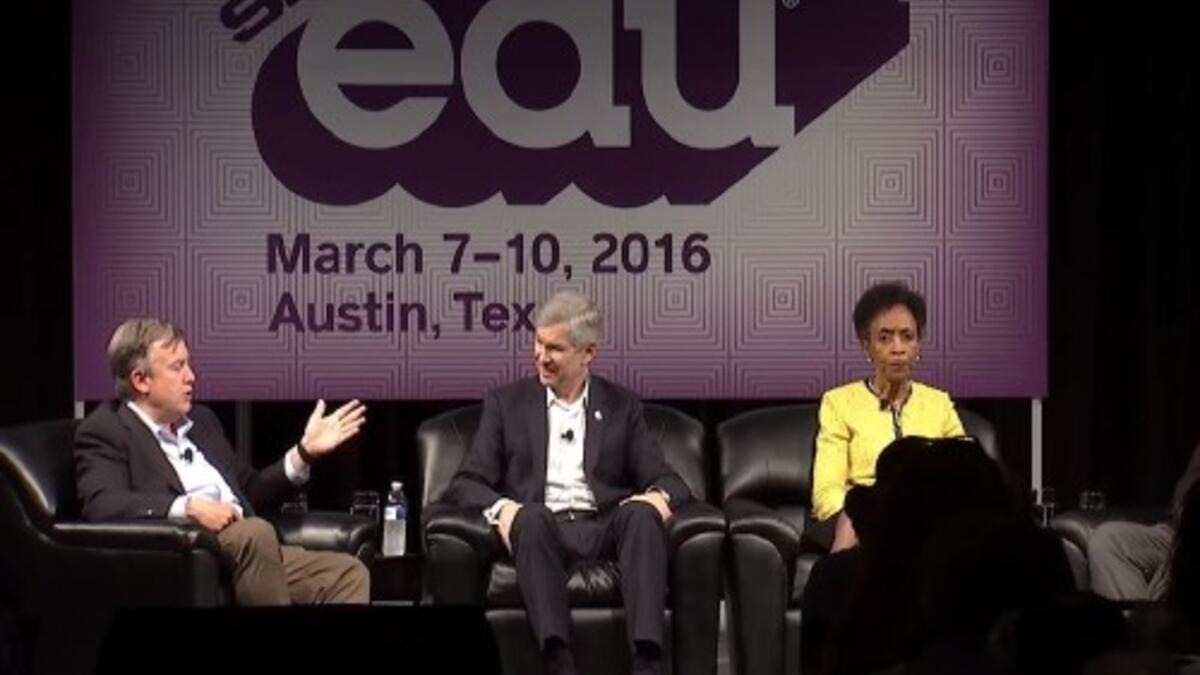
Updates from the President
Updates from President Crow: April 1, 2016
- ASU: Leading a New Wave in Higher Education
- ASU Helps Lead the University Innovation Alliance to Success
- Graduate Programs Make Big Strides in National Rankings
- Dear Legislature: Arizona's Students Are Worth Your Investment

ASU President Crow addresses the audience at SXSWedu 2016 in Austin, Texas on March 7, 2016.
ASU: Leading a new wave in higher education
They say everything is bigger in Texas, but earlier this month at SXSWedu in Austin I was given seven minutes to share my "higher education wisdom" as part of a session hosted by the University Innovation Alliance . Joining education leaders from the U.S. Department of Education, Lumina Foundation, Stanford, Georgia State and others, my talk focused on the need to evolve innovative, scalable higher education institutions if we hope to make meaningful progress toward meeting the future knowledge needs of our nation.
The United States has given rise to many excellent universities during its history, but too many people unquestionably believe that those institutions represent the pinnacle of higher education options. It is the case, however, that our country is facing unprecedented demand and complexity in terms of educational attainment. Without the will and creativity to develop and advance new higher education models, America cannot hope to achieve a substantive increase in college graduates.
Arizona State University is advancing as a leader in a new wave of higher education - one carefully designed with knowledge at its core and a student-centric focus on success. It's time for Arizona to set its own goal for college attainment and show our fellow states that progress new outcomes are possible.

ASU President Michael Crow, Georgia State President Mark Becker and University of Kansas Chancellor Bernadette Gray Little discuss the University Innovation Alliance at SXSWedu in Austin, Texas.
ASU helps lead the University Innovation Alliance to success
In a separate Austin conversation, I sat down with Bernadette Gray-Little, Chancellor of the University of Kansas, and Mark Becker, President of Georgia State University, to discuss how our 11-member University Innovation Alliance is sharing innovations to enhance broad access to quality higher education.
With a mutual commitment to public purpose and a desire to end socioeconomic disparity in college attainment, Alliance-member schools have opened up their data, formed innovation clusters around financial aid, admissions, governance and other priority issues to generate rapid, tangible outcomes. In just a little more than a year, UIA schools have produced a 3% increase in the proportion of degrees earned by low income students and a 19% increase in low income graduates among its participating public institutions.
There is a widespread perception that large-scale public universities cannot achieve the quality needed to compete with private "elite" schools due to their differentiated admission guidelines and public mission. The UIA is working actively and collaboratively to render that perception obsolete and strategically close our nation's current deficit of college graduates.
ASU is proud to help lead this groundbreaking endeavor as part of a diverse set of universities dedicated to developing customized solutions that optimize technology and talent in support of student success.
Ultimately, we will call the UIA a "win", not by being lauded for who we exclude, but by whom we graduate.

Graduate schools make big strides in national rankings
The New American University model we represent is focused on the achievement of comprehensive excellence, access and societal impact. Our four-part university mission includes our commitment to earning national standing for our colleges and schools. In mid-March we were excited to receive some important news that brings ASU another step closer to realizing these metrics.
In the latest U.S. News & World Report rankings of our nation's best graduate programs, ASU's Mary Lou Fulton College of Education and the School of Public Affairs, in the College of Public Service and Community Solutions both broke into the top 15. MLFTC placed ahead of programs at UC Berkeley and New York University, while SPA ranked ahead of Columbia and Georgetown.
As if that weren't enough to celebrate, both our Sandra Day O'Connor College of Law and our School of Art, in the Herberger Institute for Design and the Arts, placed in the top 25. The College of Law ranked ahead of Ohio State University and UC Davis, and the School of Art programs listed ahead of the University of Chicago and Cornell.
Even after nearly 15 years at ASU, I continue to encounter perceptions that insist it is impossible for a university to be both large and high quality. Although rankings are not definitive measures of efficacy for colleges and universities, they can serve as indicators of institutional progress and impact. For ASU, they reaffirm what we already know - we are actively working to demonstrate excellence on a national scale and we have no plans to slow down.

Dear Legislature: Arizona's students are worth your investment
Two days after the U.S. News & World Report rankings were announced, and as state budget talks moved forward, I joined ABOR President Eileen Klein, NAU President Rita Cheng, and UA President Ann Weaver Hart in issuing an open letter to the Arizona Legislature in the Arizona Capitol Times.
Our letter reminded state legislators of the critical function that Arizona higher education serves in the continued growth, prosperity and quality of life in Arizona. State funding currently covers 34% of the cost to educate each Arizona student. You can see here how Arizona is faring in terms of post-recession higher education investment.
The facts about the value of a college degree to the individual, our state and society speak for themselves:
- College graduates earn more over the course of a lifetime; have better access to health care; and their children are more likely to earn a college degree.
- In FY 2015, Arizona's public universities were responsible for 102,000 jobs and $11.1 billion in total economic impact.
- College graduates are less likely to be incarcerated, suffer from unemployment or receive government assistance.
We also asked legislators to allocate $32 million (roughly one-third of last year's budget cuts) to Arizona's universities and to hold us accountable for producing outcomes that demonstrate the return on their investment. If you agree that Arizona's ranking of 49th in the nation related to public funding of higher education is unacceptable, please consider visiting sundeviladvocates.org